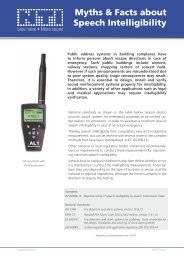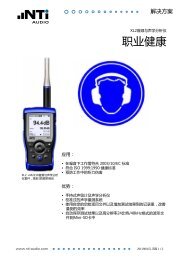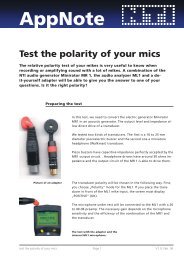AES3, AES/EBU
AES3, AES/EBU
AES3, AES/EBU
Create successful ePaper yourself
Turn your PDF publications into a flip-book with our unique Google optimized e-Paper software.
www.nti-audio.com<br />
ApplicAtion note<br />
<strong><strong>AES</strong>3</strong>, <strong>AES</strong>/<strong>EBU</strong><br />
<strong><strong>AES</strong>3</strong>: Audio Engineering Society Standard #3<br />
<strong>EBU</strong>: European Broadcasting Union<br />
The <strong><strong>AES</strong>3</strong> interface was already specified in 1985 and it was<br />
made a standard in 1992. Ever since the standard is recurrently<br />
updated and adapted to advanced requirements. From<br />
there the standard is very universal and it‘s applicability is<br />
manifold. On the other side this makes it somewhat complex.<br />
Specifications<br />
• 2 channels<br />
• balanced transmission<br />
• XLR connector<br />
• audio data up to 24Bit / 192kHz<br />
• cable length: 100m and more<br />
• impedance: 110Ohm (± 20%)<br />
• level: 2 - 7 Vpp at the output side of a unit<br />
(at 110 Ohm, without long wiring)<br />
•<br />
large channel status information<br />
Jan 12, page 1 / 6
www.nti-audio.com<br />
Comparing <strong><strong>AES</strong>3</strong> and <strong>AES</strong>/<strong>EBU</strong><br />
ApplicAtion note<br />
The <strong><strong>AES</strong>3</strong> digital audio interface and the <strong>AES</strong>/<strong>EBU</strong> digital audio<br />
interface only differ in this one detail: the <strong>EBU</strong> (European Broadcasting<br />
Union) standard regulates that coupling transformers are<br />
mandatory at each interface be it sending or receiving side. This is<br />
only optional with the <strong><strong>AES</strong>3</strong> standard.<br />
Functionality<br />
One aim developing the <strong><strong>AES</strong>3</strong> standard was to allow for digital<br />
data transmission the reuse of the cable network well established<br />
for analog audio signal transmission, a network often hunderds of<br />
kilometres long in facilities as broadcast studios. These are balanced<br />
cables and they allow signal transmission with frequencies<br />
up to about 10 MHz with cable length up to 300m if appropriate<br />
signal equalization is performed. To transmit digital signals over<br />
these analog audio cables some conditions have to be met, but<br />
they can easy be fulfilled:<br />
• The signal has to be free of a DC component as transformers<br />
may be within the transmission chain.<br />
• The signal itself must carry clock information as there are no<br />
separate lines to feed the bit clock and sample clock.<br />
• Reversal of polarity should not have any influence on retrieval<br />
of the audio information.<br />
These conditions can be met by a bi-phase-mark coding scheme.<br />
Figure:<br />
With Bi-Phase-Mark coding each bit boundary is marked by switching over signal polarity.<br />
To distinguish a digital ´1´ from digital ´0´ an additional transition is inserted in the middle<br />
of a ´1´ bit. This code is proof against polarity reversal and it contains no DC component.<br />
So it can pass transformers. Even long ´0´ or ´1´sequencies within the bit stream contain<br />
recurrent alternations in signal state. So the bit clock is easily recovered.<br />
page 2 / 6
www.nti-audio.com<br />
ApplicAtion note<br />
With <strong><strong>AES</strong>3</strong> each sample of one audio channel is part of the so<br />
called subframe. A subframe consists of 32 bits arranged in this<br />
format:<br />
Figure:<br />
The <strong><strong>AES</strong>3</strong> subframe. Transmission of bits takes place as numbered. One may imaginate<br />
the subframe be shifted out the paper to the right.<br />
• Audio data: 20 bits are available for audio data. If more bits are<br />
required 4 Aux bits (auxiliary bits) can broaden sample resolution.<br />
Independent from sample resolution the most significant<br />
bit (MSB) is located at leftmost position (bit position 27). Bit<br />
positions not used are filled with zeros.<br />
• AUX: Mostly the 4 Aux bits serve to broaden audio sample<br />
resolution to 24 bits or they are set to zero. Only occasionally<br />
the 4 bits serve to transmit an additional low quality audio<br />
signal, typically a speech (tally) signal.<br />
• Parity Bit (P): This bit serves to detect transmission errors. It’s<br />
digital value is set on the transmitting side the way to get an<br />
even number of ´1´s in the range of bits 4 -31. The receiver<br />
tests if an even number of ´1´ reached it’s input. If not it messages<br />
a parity error.<br />
• Validity (V): Primary this bit was intended to mark invalid or<br />
defective sample values. This bit when low indicates that the<br />
sample value is valid. Samples flagged invalid should not be<br />
taken into account for further processing e.g. for digital to analog<br />
conversion (D/A).<br />
Common practice is a somewhat different disposal of the validity<br />
bit. A CD-player in most cases can perfectly correct a sample error<br />
but sometimes a correction is impossible. In this case the validity<br />
bit is set to ´1´.<br />
Digital interfaces may also transport compressed audio data as<br />
MP3, Dolby Digital . It´s not possible to convert back such data<br />
directly to analog by digital to analog conversion . So also with<br />
compressed data the validity bit is set to ´1´.<br />
• User Bit (U): With each subframe one userbit is transmitted<br />
(see paragraph “Important terms for further information).<br />
• Channel Status (C): <strong><strong>AES</strong>3</strong> channel status comprises 24 byte<br />
or 24byte* 8 bit/byte = 192 bit of information. As each subframe<br />
includes just one channel status bit a block of 192 subframes<br />
is required until the full channel status information is<br />
transmitted. The start of a channel status block is flagged by a<br />
special SYNC pattern used to indicate the start of a subframe.<br />
page 3 / 6
www.nti-audio.com<br />
ApplicAtion note<br />
Figure:<br />
Just one bit of 192 bits channel status information is transmitted per subframe. At a<br />
sample frequency of 48 kHz transmitting all this bits takes 4ms.<br />
• Synchronisation (SYNC): Bi-Phase-Mark coding implies bit<br />
clock information, but subframe clock isn’t part of this coding<br />
scheme. Now as only one (balanced or unbalanced) signal line<br />
is available also this clock must be extractable from the signal.<br />
For this purpose each subframe starts with a SYNC header consisting<br />
of 4 bits. Three different types of headers are defined,<br />
named preambles in technical terminology, each indicating special<br />
positions in the serial data stream:<br />
• X-Preamble: start subframe channel A<br />
• Y-Preamble: start subframe channel B<br />
• Z-Preamble: start subframe channel A and at the same time<br />
start of a 192 bit channel status block<br />
Preamble bits are coded a way violating the bi-phase-mark coding<br />
rule. The receiver so is enabled to distinguish the preamble bits<br />
from ordinary coded bits.<br />
Two subsequent subframes - we talked about subframes only<br />
until now - form a <strong><strong>AES</strong>3</strong>-FRAME. As each subframe transports<br />
the signal of one channel the <strong><strong>AES</strong>3</strong>-frame makes available two<br />
separate channels named A and B. So the <strong><strong>AES</strong>3</strong> framework can<br />
be charged with a stereo signal. Channel A takes the left part ,<br />
channel B the right one of the stereo signal.<br />
page 4 / 6
www.nti-audio.com<br />
ApplicAtion note<br />
Both channels A and B can of course not only accept stereo signals<br />
but 2 totally independent mono signals of same sampling<br />
frequency. This causes the channel nomination to be different<br />
from L (left) and R (right). Likewise it is possible to combine the<br />
transmission capacity of both channels to transmit a single signal<br />
but now with advanced sampling rate (96kHz, 192kHz). This technology<br />
is called S/MUX mode, double wire mode or according the<br />
<strong>AES</strong> “Single Channel Double Frequency” mode. (for more details<br />
see the appendix “1C2F Mode” in the Digilyzer user manual)<br />
Important to keep in mind: As each of the two frame channels<br />
is “embedded” in it’s appropriate subframe each disposes of it’s<br />
own channel status and user data!<br />
Channel Status<br />
Channel status information can be tailored for two different user<br />
groups: professionals and consumers. Applications within these<br />
two groups are very different and so are the channel status information<br />
associated. From there for each user group a subcode list<br />
(also called format) exists, defining how channel status bits have<br />
to be interpreted.<br />
• Consumer Area: Channel status data serve to prevent copying<br />
of copyrighted audio material in excess of one copy.<br />
• Professional Area: Here practice demands for reliable information<br />
about quality, type and source of the signal. Further information<br />
on synchronization is asked.<br />
page 5 / 6
www.nti-audio.com<br />
ApplicAtion note<br />
Figure:<br />
The first bit within the block of channel status bits determines how further channel status<br />
information has to be interpreted, as consumer or as professional data. Devices as NTi<br />
Audio’s Digital Audio Analyzer DL1 automatically display as plaintext the bit interpretation.<br />
By agreement <strong><strong>AES</strong>3</strong> interfaces transmit channel status information<br />
in the professional format. Consumer format comes into operation<br />
with interfaces like S/PDIF and TOSLINK. Anyhow it is not<br />
made impossible to transmit channel status data via <strong><strong>AES</strong>3</strong> interfaces<br />
according to the consumer format. Consequence may be<br />
at the worst that a device will completely deny operation on the<br />
incoming audio data.<br />
Cable<br />
Standard balanced analog audio cable is widespread since a long<br />
time. One may come across very different types with impedances<br />
ranging from 40 Ohm to 110 Ohm, most of the older ones with<br />
impedances below 70 Ohm. So frequently one will encounter balanced<br />
cables not matching the 110 Ohm specification for digital<br />
audio cable.<br />
Nevertheless it may be possible to transmit digital audio via up<br />
to 80m of those mismatched cables without cable equalization.<br />
Transmission up to 300m is possible in the case of good equalization.<br />
Greater distances can be bridged using cables complying<br />
with the 110 Ohm specification. Up to 240m can be bridged without<br />
and more than 750m with cable equalization. Connector pinning<br />
coincides between analog and digital cables: Pin1 = screen,<br />
PIN2 = signal (+), PIN3 = signal (-). .<br />
page 6 / 6
















